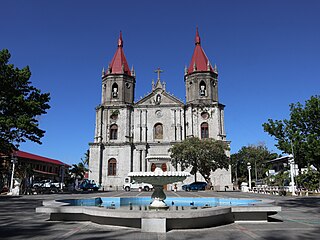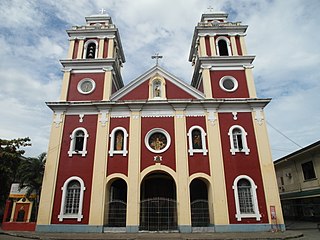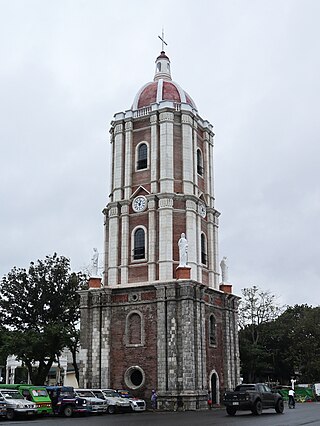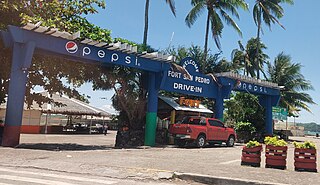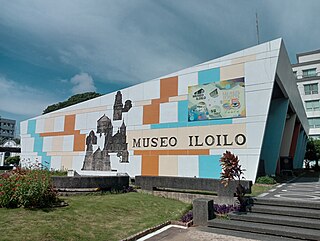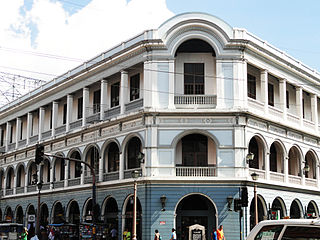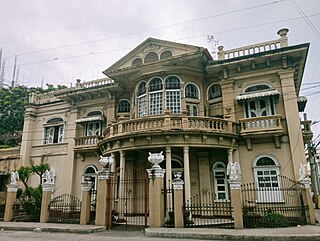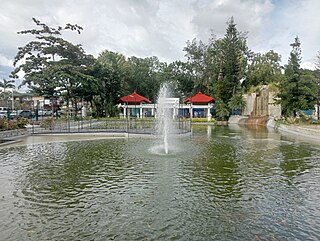15 Sights in Iloilo City, Philippines (with Map and Images)
Legend
Welcome to your journey through the most beautiful sights in Iloilo City, Philippines! Whether you want to discover the city's historical treasures or experience its modern highlights, you'll find everything your heart desires here. Be inspired by our selection and plan your unforgettable adventure in Iloilo City. Dive into the diversity of this fascinating city and discover everything it has to offer.
Sightseeing Tours in Iloilo City1. Nelly Garden
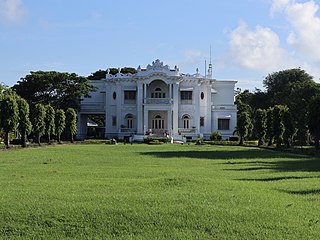
The Lopez Heritage House, also known as Mansion de Lopez or Lopez Mansion, is a heritage house in Jaro, Iloilo City, Philippines. It was built in 1928 by Ilonggo statesman Don Vicente Lopez and his wife, Doña Elena Hofileña, one of the earlier members of the prominent López family of Iloilo. The mansion was named after the couple's eldest daughter, Nelly Lopez y Hofileña. Due to its grandiose architecture highlighting the province's aristocratic past, it is regarded as the "Queen of Heritage Houses in Iloilo". The house and its 4 hectares property are open for public tours and events.
2. Iloilo Customs House
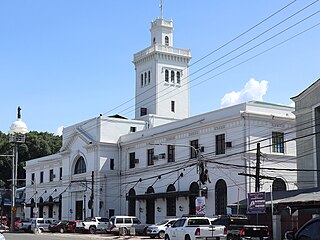
The Iloilo Customs House is a historical building in Iloilo City, Philippines. It was built in 1916 to a design by American architect Ralph Harrington Doane, then Consulting Architect of the Bureau of Public Works in the Philippine Islands. Among the three American-era customs houses in the Philippines, it is the second largest and second oldest. The building is located at Muelle Loney Street and Aduana Street along the Iloilo River and still houses the offices of the Bureau of Customs and the Bureau of Immigration in Iloilo City.
3. Saint Anne Parish Church
Santa Ana Parish Church, commonly known as Molo Church, is a neogothic Roman Catholic church located in the district of Molo in Iloilo City, Iloilo, in the Philippines. It is under the jurisdiction of the Archdiocese of Jaro. The church is recognized as "the women's church" or "the feminist church" because it only features images of female saints inside, including Saint Anne, the patron saint of Molo. The National Historical Institute declared it a national landmark in 1992.
4. San Jose Church
San Jose Placer Parish Church, also known as San José de Placer Church, is a Roman Catholic church in Iloilo City, Philippines. It is under the jurisdiction of the Archdiocese of Jaro. It was built in 1607 by the Jesuits and is considered the first ever church in the city of Iloilo. The church houses the replica of Santo Niño de Cebú, the patron saint of the Dinagyang Festival, as well as the Our Lady of the Most Holy Rosary of Iloilo. It is located in what was once known as Plaza Alfonso XII, now Plaza Libertad, a historic plaza in Iloilo City.
5. Jaro Belfry
Jaro Belfry, also known as Campanario de Jaro, is a historic free-standing bell tower located in front of the Jaro Metropolitan Cathedral in Jaro, Iloilo City, Philippines. It is one of the few belfries in the country that stands apart from the church where it belongs.
6. Camiña Balay nga Bato

Camiña Balay Nga Bato, formerly known as Avanceña House, is a 159-year-old bahay na bato in the Arevalo district, Iloilo City, Philippines. It was built in 1865 and was designed by the first parish priest of Molo, Anselmo Avanceña, for Don Fernando Avanceña and his wife, Eulalia Abaja. It was then passed on from one family to another until it came under the Camiñas family.[1] It is now owned by the fourth generation of the original owners, Gerard Camiña, former director of the Land Transportation Office in Western Visayas, and his wife, Luth Camiña. The ancestral house was declared as an Important Cultural Property by the National Museum of the Philippines (NMP) in 2015.
7. Plaza Libertad

Plaza Libertad, formerly known as Plaza Alfonso XII, is a historic plaza or town square in Iloilo City, Philippines. It is considered the site where the flag of the first Philippine Republic was raised in triumph after Spain surrendered Iloilo, the last Spanish capital in the Philippines, to the revolutionary forces led by Gen. Martin Delgado on December 25, 1898.
8. Fort San Pedro
Fort San Pedro, also called Fuerza de la Nuestra Señora del Rosario, was a military defense structure in Iloilo City, Philippines. It was built in 1602 by Pedro Bravo de Acuña to protect the city from Moro and Dutch attacks, and was completely destroyed during World War II.
9. Lizares Mansion
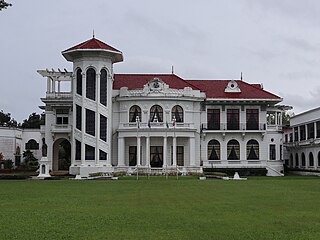
The Lizares–Gamboa Mansion, also known as Lizares Mansion or Villa Lizares, is a Beaux-Arts heritage house located in the district of Jaro in Iloilo City, Philippines. Built in 1937, it now serves as the chapel of Angelicum School Iloilo.
10. Museo Iloilo
Museo Iloilo is a provincial museum located near the Iloilo Provincial Capitol in Iloilo City, Philippines. It is the first government-sponsored museum in the Philippines outside of Metro Manila. The museum houses a collection of Iloilo's cultural heritage.
11. Eusebio Villanueva Building
The Eusebio Villanueva Building, also known as E. Villanueva Building or simply Villanueva Building, is a neoclassical building located along the historic Calle Real in Iloilo City Proper, Iloilo City, Philippines. Built in 1927, it was originally known as the Washington International Hotel. The hotel catered to American, British, and Spanish patrons, as well as Chinese bankers and merchants.
12. Arroyo Fountain
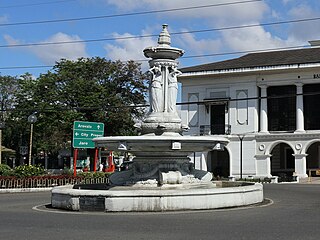
Arroyo Fountain is a historical landmark in Iloilo City, Philippines. It is located in front of Casa Real de Iloilo, or the Old Iloilo Provincial Capitol, in Iloilo City Proper. It was named after Senator José María Arroyo, who authored the law, Republic Act No. 3222, that established the then Iloilo Metropolitan Waterworks in 1925.
13. Plazoleta Gay
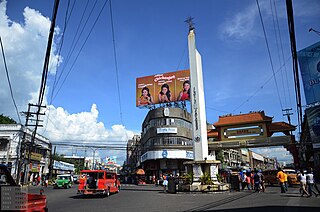
The Plazoleta Gay, also known locally as Socorro Crossing and formerly referred to as Plaza Gay, is an intersection and diagonal crossing located in downtown Iloilo City, Philippines. It is situated in front of Hua Siong College, Socorro Drug, Locsin-Coscuella Building, and Terranza Residences, and connects Ledesma, Iznart, Arroyo, J.M. Basa, and Iznart Extension Streets. At the center of the intersection stands a white commemorative obelisk, topped with a dove.
14. Celso Ledesma House
The Celso Ledesma House, or Celso Ledesma Mansion, also known as Eagle House, is a heritage house located in Iloilo City, Philippines. Situated within the Calle Real Heritage Zone in Iloilo City Proper, the house was built in 1922 by engineers Mariano Cacho and Mariano Salas for Don Celso Ledesma. During World War II, the Japanese imperial forces earmarked the house for an important official. However, as the official never arrived in Iloilo, the house and all its furniture were spared from requisition or damage.
15. Lapaz District Plaza
La Paz Plaza, also known as Plaza La Paz, is an urban park and town square located in the district of La Paz in Iloilo City, Philippines. It is the largest among six district plazas in Iloilo City, with a land area of about 3.5 hectares (35,000 m2). The redevelopment of the plaza was inaugurated on March 18, 1998, by the then-President Fidel V. Ramos.
Share
How likely are you to recommend us?
Disclaimer Please be aware of your surroundings and do not enter private property. We are not liable for any damages that occur during the tours.
